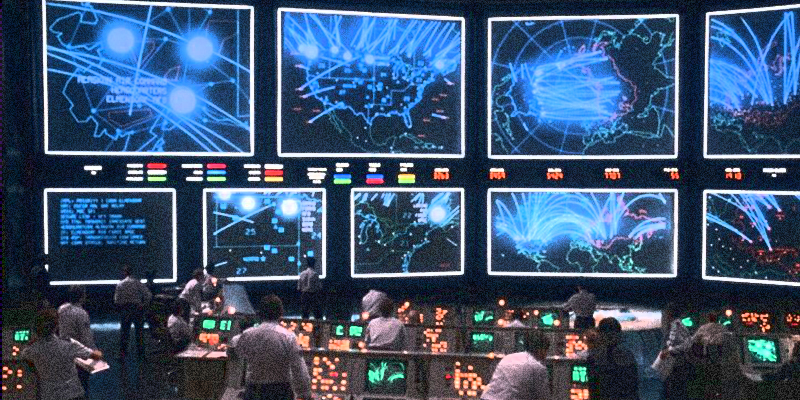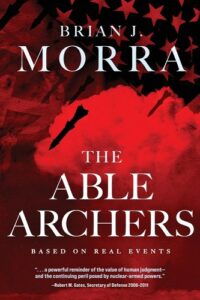Did you know that this fall will be the fortieth anniversary of the worst nuclear war crisis in world history? You may remember that 1983 was the year that Microsoft Word was introduced but are completely unaware of the nuclear war crisis. After all, American school children didn’t practice ‘duck and cover’ drills under their desks in 1983, as their predecessors had in 1962.
The events in 1983 were at least as dangerous as the Cuban Missile faceoff between the Untied States and the Soviet Union in October 1962, yet they remain largely unknown. Unlike in 1962, when President John F. Kennedy’s televised speeches received blanket coverage and alarmed the world, the 1983 crisis played out mostly hidden from public view.
The trigger event for the 1983 crisis was one Americans were aware of because the Ronald Reagan administration made sure of it. In the early morning hours of September 1, 1983, the Soviet Air Defense Forces shot down an unarmed civilian Korean Air Lines 747 plane off the coast of Sakhalin Island, north of Japan. The White House blamed the Kremlin for intentionally and knowingly killing 269 civilian passengers and crew.
What was unknown to American citizens was the Korean tragedy nearly led to a shooting war between the United States Air Force and the Soviet Union. While the Western media covered the KAL event extensively, the press was ignorant of the immediate danger of war it created or that it was the opening chapter of a global crisis that played out over the following ten weeks.
In contrast to 1962, Washington and Moscow weren’t communicating during the 1983 crisis. Misconstruing American motivations, many leaders in the Kremlin were convinced the U.S. was planning a nuclear first strike on the Soviet Union. In fact, the Soviet KGB had a massive intelligence collection effort called Operation “RYaN” that was designed to find indications of a Western first strike attack on the USSR. Each side was stumbling toward nuclear Armageddon like blindfolded boxers.
The second crisis occurred mere weeks after the Korean Air Lines shootdown—just after midnight on September 27, 1983. At the Soviets’ National Missile Defense Center, some sixty miles outside of Moscow, Russian missile warning satellites reported several waves of intercontinental ballistic missile (ICBM) launches from the western United States. The watch commander that fateful night was Soviet Air Defense Forces officer Lieutenant Colonel Stanislav Petrov. He was an expert on the Soviets’ satellite systems, and he made the snap judgment, under enormous pressure, that the ICBM ‘launches’ were spurious signals—false alarms. His advice to his chain of command was to treat the reports as errors and not to initiate a general Soviet nuclear strike on the United States. Petrov was correct but his career was ended due to charges that he failed to follow establish protocol during his watch that night.
The United States and its allies were unaware of the Petrov incident until the late 1990s. It could have led to a general nuclear exchange in September 1983, but for Petrov’s cool mindedness. Soviet nuclear forces were placed on heightened alert and were poised to act when the third and final crisis occurred just weeks later.
In the first ten days or so of November 1983, NATO conducted a major nuclear war exercise called Able Archer 83. It was the culminating phase of a series of interlocking NATO war games that commenced in September. Boasting a highly realistic scenario, the NATO exercises progressed from conventional war in Central Europe to the massive use of chemical weapons, and finally to Able Archer’s nuclear phase. There were several elements that made Able Archer look like the real thing to Soviet Intelligence, and it took place during a period of broken relations between Moscow and the West. To the Kremlin, Able Archer 83 looked like the nightmare scenario predicted by the KGB’s Operation RYaN.
Western citizens were unaware of these specific crises and the danger they posed. They had no idea that the world was on the brink of nuclear war for the first time since the Cuban Missile Crisis.
Ironically, the prospect of nuclear war was very present in popular entertainment back in 1983.
The top-rated motion picture of the year was the Star Wars classic, “The Return of the Jedi”. Many moviegoers saw Darth Vader’s galactic Empire as a stand-in for the Soviet Union. In fact, President Ronald Reagan gave a speech in March 1983 in which he labeled the Soviet Union an “evil empire” and the “focus of evil in the modern world.” Another huge Hollywood hit that year was “The Right Stuff”, which portrayed America’s astronauts as Cold War warriors striving to win the space race against the USSR. Lastly, there was “War Games”, a film that directly addressed the horror of a nuclear war between the United States and the Soviet Union. “War Games” added a new and inventive twist—artificial intelligence and super computers run amok.
Not to be outdone, television offered “The Day After”, a chilling tale of a nuclear exchange between America and the Soviet Union set in the American Midwest. Ironically, the television movie was first aired on November 20, 1983, just days after the worst real nuclear standoff in Cold War Europe began to wind down. Ronald Reagan screened “The Day After” in the White House on October 10th. He confided in his diary that the movie “left me greatly depressed”. It seems evident “The Day After”, along with a nuclear war briefing he received at the Pentagon that fall, affected Reagan’s view of nuclear weapons and the need for serious arms control.
Ratings for the initial run of “The Day After” were stunning. It was seen by sixty-two percent of households in the U.S., representing at least 100 million viewers on the first night it aired. “The Day After” generated tremendous media coverage and fostered a serious national debate over nuclear weapons.
In popular music, two of the most critically acclaimed albums of the year were R.E.M.’s debut collection, “Murmur” and U2’s third record, “War”. The R.E.M. album opens with the ominously mysterious song “Radio Free Europe”. U2’s “War” explores the physical and emotional toll of human conflict. Neither record explicitly examines nuclear war, but both provide an anxious soundtrack to a very dangerous year—the most dangerous year in human history, according to many observers.
If the 1983 crisis was so bad, why is it still largely unknown? For starters, U.S. government security classification kept most of the critical documents in the shadows until around 2015, when some papers were finally declassified. Another factor is that the 1983 events were not concentrated in time like the thirteen days of the Cuban crisis. Rather, the events played out over a much longer time frame. In 1962, the White House publicly trumpeted its resolution of the crisis. But in 1983, the White House didn’t even realize it was dealing with an almost unimaginable nuclear crisis until after it had passed.
If the events of 1983 were not well understood at the time, they were depicted in popular culture in later years.
In 1986, the investigative reporter Seymour Hersh published a best-selling non-fiction book called “The Target is Destroyed” about the first of the three crises—the Soviet shoot down of Korean Airlines flight 007. Hersh’s book generated interest at the time but is largely forgotten now.
Danish film makers produced a full-length docudrama called “The Man Who Saved the World” in 2013. The movie tells the story of the second crisis—the Soviet detection of an American first strike nuclear attack that turned out to be a false alarm. Lieutenant Colonel Stanislav Petrov is profiled in the film. The movie had a limited release in the United States, and it made little impression on the public. Strangely, the movie also didn’t connect the Petrov incident to the fraught geo-political situation that existed in the aftermath of the KAL shoot down, which had occurred less than four weeks prior.
The Able Archer crisis was depicted in a television series, “Deutschland 83”, that aired in 2015, premiering in the United States in German with English subtitles. The series went largely overlooked in America. It was released in Germany later that year and in the United Kingdom in 2016. It was a sleeper hit in Germany but not elsewhere.
In the spring of 2022, my historical novel The Able Archers was published. It tells the story of the interconnected crises of the fall of 1983 through the eyes of a young American intelligence officer and a more seasoned Soviet military intelligence official. It has been optioned by Legendary Entertainment for the rights to produce a motion picture or a television series. Perhaps this year— the fortieth anniversary of the 1983 crisis—we’ll finally see a popular treatment of a near nuclear Armageddon and how a few people prevented it. Unfortunately, Russia’s awful invasion of Ukraine and the Kremlin’s continuing threats of nuclear escalation in Ukraine make fears of World War III relevant again.
***


















